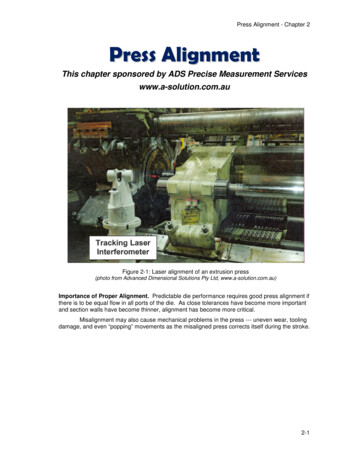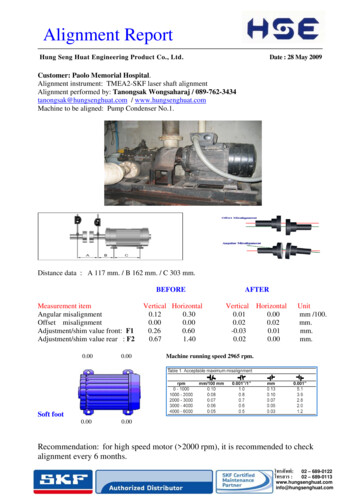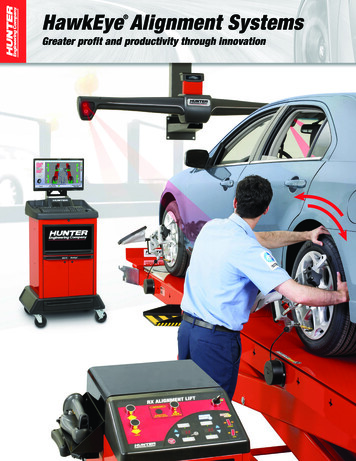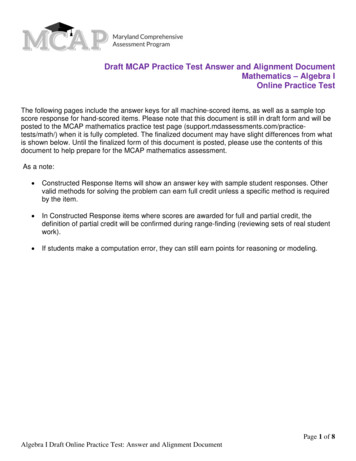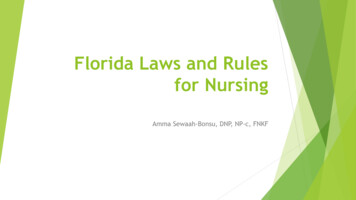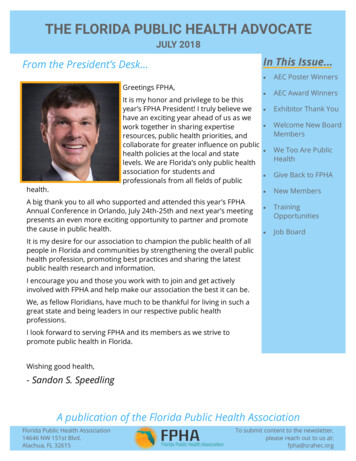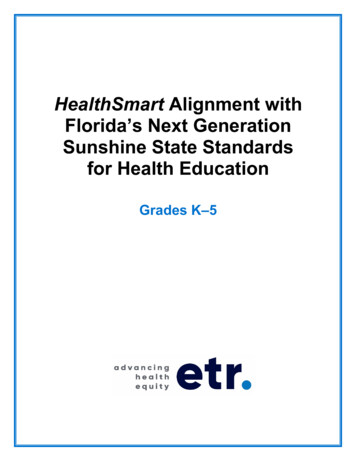
Transcription
HealthSmart Alignment withFlorida’s Next GenerationSunshine State Standardsfor Health EducationGrades K–5
HealthSmart K-5 Alignment with Florida’s Next Generation Sunshine State Standards for Health EducationGrade K2LessonsCore ConceptsHE.K.C.1.1Recognize healthy behaviors.HE.K.C.1.3Recognize ways to prevent common communicable diseases.K – 2 [expressing emotions], 5 [tooth care],6 [handwashing], 9 [getting help when ill],21 [healthy eating] , 22 [food choices],23 [drinking water], 24 [physical activity],26, 27 [avoiding tobacco use],29 [avoiding smoke]K – 4 [keeping the body healthy],5, 6, 7 [health habits], 21 [nutrition],24 [physical activity],26, 27 [effects of tobacco]K – 6 [handwashing]9 [help from adults when ill]HE.K.C.1.4Recognize ways to prevent childhood injuries in the home,school, and community settings.K – 12, 13, 14 [street safety], 15 [passengersafety], 16 [poisons], 17 [firearms]18, 19 [emergencies], 20 [safe decisions]HE.K.C.1.5Recognize there are body parts inside and outside of thebody.K – 4 [limbs, heart, lungs]HE.K.C.1.2Recognize the physical dimensions of health.Internal and External InfluencesHE.K.C.2.1Name healthy behaviors that family members shouldpractice.HE.K.C.2.2Recognize the characteristics of a friend.HE.K.C.2.3Identify members of the school and community who supportpersonal-health practices and behaviors.HE.K.C.2.4Explain the importance of rules to maintain health.K – 3 [emotional support], 11 [avoidingbullying], 14 [pedestrian safety],22 [eating healthy foods],23 [drinking water], 25 [physical activity],26 [avoiding smoke],27 [secondhand smoke]K – Not coveredCovered in 1 – 3K –3, 7, 8, 9, 10, 11, 18, 22K – 7 [medicines], 11 [bullying], 12 [traffic],13, 14 [pedestrian safety], 15 [passengersafety], 16 [avoiding poisons], 17 [firearmsafety], 20 [safe decisions]Accessing InformationHE.K.B.3.1Recognize warning labels and signs on hazardous productsand places.K – 14 [crosswalk signals], 16 [poisons]
HealthSmart K-5 Alignment with Florida’s Next Generation Sunshine State Standards for Health EducationGrade K (continued)3LessonsAccessing Information (continued)HE.K.B.3.2Recognize school and community health helpers.K – 3 [people who care], 9 [getting help],10 [help to be safe], 11 [help for bullying],14 [crossing guards], 18 [emergency help],19 [9-1-1]Interpersonal CommunicationHE.K.B.4.1Recognize healthy ways to express needs, wants, andfeelings.HE.K.B.4.2Demonstrate listening skills to enhance health.K – 1 [sharing information], 2 [expressingemotions], 3, 9, 10 [asking for help]HE.K.B.4.3Identify the appropriate responses to unwanted andthreatening situations.K – 9 [help if sick/injured],11 [telling adult about bullying],19 [calling 9-1-1]K – 1 [sharing information]Decision MakingHE.K.B.5.1Name situations when a health-related decision can be madeindividually or when assistance is needed.HE.K.B.5.2Recognize healthy options to health-related issues orproblems.HE.K.B.5.3Recognize the consequences of not following rules/practiceswhen making healthy and safe decisions.K – 20 [decisions about safety],28 [avoiding secondhand smoke]K – 20 [decisions about safety]K – 12 [traffic], 13, 14 [pedestrian safety], 15[passenger safety], 16 [avoiding poisons],17 [firearm safety], 20 [safe decisions]Self-ManagementHE.K.P.7.1Identify healthy practices and behaviors to maintain orimprove personal health.K – 1 [valuing differences], 2 [managing anger]5, 6 [personal care],13, 14 [pedestrian safety],15 [passenger safety], 16 [poison safety],17 [firearm safety], 19 [calling 9-1-1]22 [choosing healthy foods],23 [drinking water],24 [physical activity],29 [avoiding secondhand smoke],30 [being tobacco free]AdvocacyHE.K.P.8.1Help others to make positive health choices.K – 11 [preventing bullying],23 [physical activity],28, 30 [be tobacco free]
HealthSmart K-5 Alignment with Florida’s Next Generation Sunshine State Standards for Health EducationGrade 14LessonsCore ConceptsHE.1.C.1.1:Identify healthy behaviors.HE.1.C.1.2:Recognize the physical and social dimensions of health.HE.1.C.1.3:Describe ways to prevent common communicable diseases.HE.1.C.1.4:Identify ways to prevent childhood injuries in the home,school, and community settings.HE.1.C.1.5:Identify the correct names of human body parts.HE.1.C.1.6:Identify health-care providers.1 – 1 [belonging], 2 [family relationships],3 [friendships], 4 [expressing emotions],5 [handwashing], 6 [tooth care],7 [weather & sun safety], 8 [sleep],18 [preventing bullying],21 [eating breakfast], 22 [drinking water],24, 25 [physical activity],26 [avoiding tobacco smoke],27 [avoiding tobacco use]1 – 1 [belonging], 2 [families]3 [friends], 5, 6 [health habits], 8 [sleep],24 [physical activity, growing bodies],26 [effects of tobacco]1 – 5 [handwashing]1 – 7 [dressing for weather], 9 [being safe],10 [pedestrian safety], 11 [safe routes],12, 13 [passenger safety],14 [playground safety], 15, 16 [fire safety],20 [inappropriate touch]1 – Not coveredCovered in K – 41 – Not coveredInternal and External InfluencesHE.1.C.2.1:1 – 1 [belonging], 2 [families], 3 [friends],Identify how children learn health behaviors from family and27 [peers and tobacco use],friends.29 [support for avoiding tobacco use]HE.1.C.2.2:1–3Explore the ways that a friend would act in a variety ofsituations.HE.1.C.2.3:1 – 11 [safe routes and havens],Identify what the school and community do to support13 [school bus safety],personal-health practices and behaviors.14 [playground safety], 17 [emergency help],18 [reporting bullying],20 [help for inappropriate touch],29 [help to stay tobacco free]HE.1.C.2.4:1 – 10 [pedestrian safety], 12 [passenger safety],Recognize health consequences for not following rules.13 [school bus safety],14 [playground safety],15, 16 [fire safety], 18 [bullying],26 [family rules around tobacco use]
HealthSmart K-5 Alignment with Florida’s Next Generation Sunshine State Standards for Health EducationGrade 1 (continued)5LessonsAccessing InformationHE.1.B.3.1:Determine the meaning of warning labels and signs onhazardous products and places.HE.1.B.3.2:Identify trusted adults and professionals who can helppromote health.1 – Not coveredPoisons covered in K – 161 – 1, 9, 11, 29Interpersonal CommunicationHE.1.B.4.1:Identify healthy ways to express needs, wants, and feelings.HE.1.B.4.2:Describe good listening skills to enhance health.1 – 4 [different emotions],29 [staying tobacco free]1 – 3 [could include in qualities of a friend],17 [calling 9-1-1]HE.1.B.4.3:Describe ways to respond when in an unwanted, threatening,or dangerous situation.1 – 17 [calling 9-1-1], 18 [bullying],20 [inappropriate touch],29 [avoiding tobacco smoke]Decision MakingHE.1.B.5.1:Describe situations when a health-related decision can bemade individually or when assistance is needed.HE.1.B.5.2:Identify healthy options to health-related issues or problems.HE.1.B.5.3:Explain the consequences of not following rules/practiceswhen making healthy and safe decisions.1 – 9 [help to be safe],29 [avoiding tobacco use]1 – 8 [getting enough sleep],9 [help to be safe],11 [safe routes],22 [choosing water]26 [avoiding tobacco smoke]1 – 10 [pedestrian safety], 12 [passenger safety],13 [school bus safety],14 [playground safety], 15, 16 [fire safety]Self-ManagementHE.1.P.7.1:Tell about behaviors that avoid or reduce health risks.1 – 5 [handwashing], 7 [weather, sun safety],8 [sleep], 10 [pedestrian safety],11 [safe routes], 12, 13 [passenger safety],14 [playground safety], 15, 16 [fire safety]17 [calling 9-1-1], 19 [being safety smart],21 [eating breakfast], 22 [drinking water],24, 25 [physical activity],26, 29 [avoiding tobacco smoke]AdvocacyHE.1.P.8.1:Encourage others to make positive health choices.1 – 3, 12, 19, 22, 28
HealthSmart K-5 Alignment with Florida’s Next Generation Sunshine State Standards for Health EducationGrade 26LessonsCore ConceptsHE.2.C.1.1Identify that healthy behaviors affect personal health.HE.2.C.1.2Recognize the physical, mental/emotional and socialdimensions of health.HE.2.C.1.3Describe ways a safe, healthy home environment canpromote personal health.HE.2.C.1.4Describe ways to prevent childhood injuries in the home,school, and community settings.HE.2.C.1.5Recognize the locations and functions of major humanorgans.HE.2.C.1.6Determine when it is important to seek health care.2 – 1 [family relationships], 2 [growth],3, 4 [troublesome feelings],5 [handwashing], 6 [medicine use],14, 15 [preventing bullying],16 [drinking water], 17 [eating breakfast],18 [healthy snacks],19 [eating fruits & vegetables],22, 21 [physical activity], 22 [stretching],23, 24, 26 [avoiding tobacco use],2 – 1 [families], 3 [feelings],5, 6, 7, 8 [healthy habits],20 [body image/physical activity],23 [effects of tobacco]2 – 2 [family relationships], 4 [support],6 [medicine safety],25 [support for being tobacco free]2 – 9, 10, 11, 12, 132 – Not covered2–6Internal and External InfluencesHE.2.C.2.1Describe how family rules and practices influence healthbehaviors.HE.2.C.2.2Describe how friends' health practices influence healthbehaviors of others.HE.2.C.2.3Describe how the school and community influence healthbehaviors of children.HE.2.C.2.4Explain the ways that rules make the classroom, school, andcommunity safer.2–12 – 5 [how germs spread],8 [helping friends stay healthy],15 [preventing bullying],16 [drinking water], 23 [tobacco use]2 – 25 [support for being tobacco free]2 – 5 [avoiding germs],6 [medicine safety], 9 [pedestrian safety],10 [passenger safety], 11 [water safety],12 [bike safety], 14 [bullying]Accessing InformationHE.2.B.3.1Understand the meaning of warning labels and signs onhazardous products.2 – 23 [tobacco products]
HealthSmart K-5 Alignment with Florida’s Next Generation Sunshine State Standards for Health EducationGrade 2 (continued)7LessonsAccessing Information (continued)HE.2.B.3.2Select trusted adults and professionals who can helppromote health.2 – 4, 25Interpersonal CommunicationHE.2.B.4.1Demonstrate healthy ways to express needs, wants,feelings, and listening skills to enhance health.HE.2.B.4.3Demonstrate ways to respond to unwanted, threatening, ordangerous situations.2 – 3 [troublesome feelings], 4 [getting help],16 [drinking water],25 [support for staying tobacco free]2 – 15 [getting help for bullying],Decision MakingHE.2.B.5.1Differentiate between situations when a health-related decisioncan be made individually or when assistance is needed.HE.2.B.5.2Name healthy options to health-related issues or problems.HE.2.B.5.3Compare the consequences of not following rules/practiceswhen making healthy and safe decisions.2 – 7, 8, 242 – 4 [troublesome feelings],5 [preventing colds],6 [medicines], 9 [pedestrian safety],10 [passenger safety], 11 [water safety],12 [bike safety], 17 [breakfast foods],17 [healthy snacks],26 [avoiding tobacco use]2 – 9 [pedestrian safety],10 [passenger safety], 11 [water safety],12 [bike safety]Goal SettingHE.2.B.6.1Establish a short-term personal health goal as a class andtake action toward achieving the goal.2 – 13 [being safety smart],19 [eating fruits & vegetables],21 [being physically active],22 [stretching as a class]Self-ManagementHE.2.P.7.1Demonstrate health behaviors to maintain or improvepersonal health.2 – 4 [getting help for troublesome feelings],5 [handwashing], 6 [using medicines],7, 8 [healthy habits], 16 [drinking water],17 [eating breakfast], 18[healthy snacks],19 [eating fruits & vegetables],20, 21 [physical activity], 22 [stretching],25, 26 [avoiding tobacco use]AdvocacyHE.2.P.8.1Support peers when making positive health choices.2 – 8 [healthy habits], 15 [preventing bullying],16 [drinking water], 23, 26 [no tobacco use]
HealthSmart K-5 Alignment with Florida’s Next Generation Sunshine State Standards for Health EducationGrade 38LessonsCore ConceptsHE.3.C.1.1Describe healthy behaviors that affect personal health.HE.3.C.1.3Describe ways a safe, healthy classroom can promotepersonal health.HE.3.C.1.4Recognize common childhood health conditions.HE.3.C.1.5Recognize that body parts and organs work together to formhuman body systems.HE.3.C.1.6Describe why it is important to seek health care.3 – 1 [being healthy], 2 [expressing feelings],3 [family relations], 4 [friendships],5 [valuing self/others], 6, 7 [avoiding germs],8 [medicine use], 17, 21, 22 [healthy foods]18 [healthy beverages], 19 [eating breakfast],20 [eating fruits & vegetables],23, 24 [physical activity],25, 26, 27, 28 [avoiding tobacco/alcohol use]3 – 9, 10, 11 [being safety smart],13 [assessing for safety], 14, 15 [bullying]3 – Not covered3 – Not covered3–8Internal and External InfluencesHE.3.C.2.1Explore how family and friends’ traditions and customsmay influence health behaviors.HE.3.C.2.3Explore how the traditions and customs of the school andcommunity influence health behavior of children.HE.3.C.2.4Identify classroom and school rules that promote health anddisease prevention.HE.3.C.2.5Discuss the positive and negative impacts media may haveon health.HE.3.C.2.6Discuss the positive and negative impacts technology mayhave on health.3 – 3 [family], 4 [friends], 21 [food choices],27, 28 [pressure to use drugs]3 – 21 [food choices]3 – 9, 10, 11, 13 [safety rules], 14 [bullying]3 – 21 [food choices], 28 [pressure to use drugs]3 – Not coveredAccessing InformationHE.3.B.3.1Locate resources from home, school, and community thatprovide valid health information.HE.3.B.3.2Describe criteria for selecting health information, resources,products, and services.HE.3.B.3.3Describe how the media influences the selection of healthinformation, products, and services.3–13 – Not coveredCovered in Grades 4 and 53 – 21 [food choices], 28 [tobacco/alcohol use]
HealthSmart K-5 Alignment with Florida’s Next Generation Sunshine State Standards for Health EducationGrade 3 (continued)9LessonsInterpersonal CommunicationHE.3.B.4.1Identify effective verbal and nonverbal communication skillsto enhance health.HE.3.B.4.2Demonstrate refusal skills that avoid or reduce health risks.3 – 4 [getting along with friends],29 [resisting pressure]HE.3.B.4.3Demonstrate nonviolent strategies to manage or resolve conflict.3 – Not coveredCovered in 4 – 15HE.3.B.4.4Explain ways to ask for assistance to enhance personal health.3 – 15 [reporting bullying],16 [inappropriate touch]3 – 16 [inappropriate touch],29 [saying no to drugs]Decision MakingHE.3.B.5.1Recognize circumstances that can help or hinder healthydecision making.HE.3.B.5.2List healthy options to health-related issues or problems.HE.3.B.5.3Discuss the potential short-term personal impact of eachoption when making a health-related decision.HE.3.B.5.4Find a healthy option when making a decision for yourself.HE.3.B.5.5Explain when assistance is needed when making a healthrelated decision.3 – 13 [making safe choices],26 [being tobacco/alcohol free]3 – 13 [making safe choices], 17 [healthy foods],18 [healthy beverages],26 [being tobacco/alcohol free]3 – 13 [making safe choices],26 [being tobacco/alcohol free]3 – 13 [making safe choices], 17 [healthy foods],18 [healthy beverages],26 [being tobacco/alcohol free]3 – 13 [making safe choices],26 [being tobacco/alcohol free]Goal SettingHE.3.B.6.1Select a personal health goal and track progress towardachievement.HE.3.B.6.2Examine resources that could assist in achieving a smallgroup personal health goal.3 – 12 [safety goal], 22 [eating healthy foods],24 [physical activity]3 – 12 [safety goal], 22 [eating healthy foods],24 [physical activity]Self-ManagementHE.3.P.7.1Practice responsible personal health behaviors.HE.3.P.7.2Investigate a variety of behaviors that avoid or reduce healthrisks.3 – 9, 11 [being safety smart],14 [preventing bullying]3 – 6 [disease prevention],17 [healthy foods], 18 [healthy beverages],26 [being tobacco/alcohol free]AdvocacyHE.3.P.8.1Promote positive behaviors to others.3 – 7 [avoiding germs], 10, 11 [safety smart]15 [reporting bullying], 29 [avoiding drugs]
HealthSmart K-5 Alignment with Florida’s Next Generation Sunshine State Standards for Health Education 10Grade 4LessonsCore ConceptsHE.4.C.1.1Identify the relationship between healthy behaviors andpersonal health.4 – 1, 2, 3 [stress management],4, 5, 6 [troublesome feelings],7, 9 [healthy habits], 8 [protecting eyes/ears],10, 12 [risk taking], 13 [dares],14 [conflict resolution],16, 17 [healthy eating], 18 [physical activity],20, 21 [avoiding tobacco/alcohol use],25 , 26, 28 [changes of puberty]HE.4.C.1.2Identify examples of mental/emotional, physical, and socialhealth.4 – 1, 2, 3 [stress], 4, 5, 6 [feelings],7, 9 [healthy habits], 8 [protecting eyes/ears],14 [conflict resolution],16, 17 [healthy eating], 18 [physical activity],20, 21 [avoiding tobacco/alcohol use],25 [changes of puberty]4 – 11 [staying safe]HE.4.C.1.3Describe ways a safe, healthy school environment canpromote personal health.HE.4.C.1.4Describe ways to prevent common childhood injuries andhealth problems.HE.4.C.1.5Identify the human body parts and organs that work togetherto form healthy body systems.HE.4.C.1.6Distinguish differences among various healthcare providers,products, and services.4 – 3 [stress management],10, 12 [risk taking], 11 [staying safe],14, 15 [conflict resolution4 – Not covered4 – Not coveredInternal and External InfluencesHE.4.C.2.1Explain the importance of family on health practices andbehaviors.HE.4.C.2.2Explain the important role that friends/peers may play inhealth practices and behaviors.HE.4.C.2.3Explain the important roles that school and community playin health practices and behaviors.HE.4.C.2.4Recognize types of school rules and community laws thatpromote health and disease prevention.4 – 10 [risk taking], 21 [tobacco/alcohol use]4 – 13 [dares], 21 [tobacco/alcohol use]4 – 11 [staying safe]4 – 11, 12 [staying safe]
HealthSmart K-5 Alignment with Florida’s Next Generation Sunshine State Standards for Health Education 11Grade 4 (continued)Internal and External Influences (continued)HE.4.C.2.5Explain how media influences personal thoughts, feelings,and health behaviors.HE.4.C.2.6Explain how technology influences personal thoughts,feelings, and health behaviors.Lessons4 – 18 [physical activity],21 [tobacco/alcohol use]4 – Not coveredAccessing InformationHE.4.B.3.1Describe characteristics of valid health information,products, and services.HE.4.B.3.2Construct criteria for selecting health resources, products,services, and reputable technologies.HE.4.B.3.3Examine resources from home, school and community thatprovide valid health information.4 – 20 [information about tobacco/alcohol]4 – 20 [information about tobacco/alcohol]4 – 6 [help for troublesome feelings],20 [information about tobacco/alcohol],27 [help with growing up]Interpersonal CommunicationHE.4.B.4.1Explain effective verbal and nonverbal communication skillsto enhance health.HE.4.B.4.2Identify refusal skills and negotiation skills that avoid orreduce health risks.HE.4.B.4.3Discuss nonviolent strategies to manage or resolve conflict.Not coveredHE.4.B.4.4Demonstrate ways to ask for assistance to enhance personalhealth.4 – 6 [help for troublesome feelings],15 [help with serious conflicts],27 [help with changes of puberty]4 – 13 [dares], 22, 23 [tobacco/alcohol use]4 – 15 [conflict resolution]Decision MakingHE.4.B.5.1Identify circumstances that can help or hinder healthydecision making.HE.4.B.5.2Itemize healthy options to health-related issues or problems.4 – 14 [simple vs. serious conflict],28 [decision making for a healthy future]HE.4.B.5.3Predict the potential short-term impact of each option on selfand others when making a health-related decision.HE.4.B.5.4Choose a healthy option when making decisions for yourselfand/or others.HE.4.B.5.5Examine when assistance is needed to make a health-relateddecision.4 –28 [decision making for a healthy future]4 –28 [decision making for a healthy future]4 –28 [decision making for a healthy future]4 – 14 [simple vs. serious conflict],28 [decision making for a healthy future]
HealthSmart K-5 Alignment with Florida’s Next Generation Sunshine State Standards for Health Education 12Grade 4 (continued)LessonsGoal SettingHE.4.B.6.1Create a personal health goal and track progress towardachievement.HE.4.B.6.2Categorize resources that could assist in achieving a smallgroup personal health goal.4 – 9 [healthy habits],19 [eating/physical activity]4 – 9 [healthy habits],19 [eating/physical activity]Self-ManagementHE.4.P.7.2Discuss a variety of healthy practices and behaviors tomaintain or improve personal health and reduce health risks.4 – 3 [stress management],4 [help for troublesome feelings],5 [self-control], 12 [risk assessment],15 [conflict resolution]AdvocacyHE.4.P.8.1Assist others to make positive health choices.4 – 20, 24 [avoiding tobacco/alcohol use],25, 26 [healthy choices around puberty]
HealthSmart K-5 Alignment with Florida’s Next Generation Sunshine State Standards for Health Education 13Grade 5LessonsCore ConceptsHE.5.C.1.1Describe the relationship between healthy behaviors andpersonal health.HE.5.C.1.2Explain the physical, mental/emotional, social, andintellectual dimensions of health.HE.5.C.1.3Explain ways a safe, healthy home and school environmentpromote personal health.HE.5.C.1.4Compare ways to prevent common childhood injuries andhealth problems.HE.5.C.1.5Explain how human body parts and organs work together inhealthy body systems, including the endocrine andreproductive systems.HE.5.C.1.6Recognize how appropriate health care can promote personalhealth.5 – 1 [emotional health], 2 [relationships],4 [health information], 5,6 [chronic disease],7, 8 [bullying], 11 [fights],13 [helping friends],16, 17, 18, 19 [healthy eating],20, 21 [physical activity],24, 25, 26, 27, 30 [alcohol use],32, 33, 34, 35 [changes of puberty]5 – 1 [emotional health],32 [changes of puberty]5 – 9 [bullying], 10 [fights],36 [gender roles]5 – 9 [bullying], 10, 11, 12 [fights]5 – 34, 35 [reproductive systems only]5 – 38 [info and support for puberty]Internal and External InfluencesHE.5.C.2.1Predict how families may influence various healthpractices of children.HE.5.C.2.2Predict how friends/peers may influence various healthpractices of children.HE.5.C.2.3Predict how the school and community influence varioushealth practices of children.HE.5.C.2.4Give examples of school and public health policies thatinfluence health promotion and disease prevention.HE.5.C.2.5Determine how media influences family health behaviorsand the selection of health information, products, andservices.HE.5.C.2.6Describe ways that technology can influence family healthbehaviors.5 – 19 [healthy eating], 30 [alcohol use],33 [puberty and family responsibilities]5 – 7 [bullying], 11 [fights],26, 30 [alcohol use]5 – 9 [bullying], 12 [fights], 13 [helping friends],19 [eating habits]5 – 8 [bullying], 11 [fights], 24 [alcohol use]5 – 14 [media violence],27, 30 [alcohol use]5 – 7, 8, 15 [ cyberbullying]
HealthSmart K-5 Alignment with Florida’s Next Generation Sunshine State Standards for Health Education 14Grade 5 (continued)Internal and External Influences (continued)HE.5.C.2.7Discuss how various cultures can influence personal healthbeliefs.HE.5.C.2.8Investigate influences that change health beliefs andbehaviors.Lessons5 – 19 [healthy eating], 36 [gender roles]5 – 32, 33 [changes of puberty]Accessing InformationHE.5.B.3.1Discuss characteristics of valid health information, products,and services.HE.5.B.3.2Evaluate criteria for selecting health resources, products, andservices.HE.5.B.3.3Compile resources from home, school, and community,technologies that provide valid health information.5 – 4 [accurate information],38 [support for changes of puberty]5 – 4 [accurate information] ,38 [support for changes of puberty]5 – 4 [accurate information], 5 [chronic disease],13 [helping friends], 31 [alcohol problems],38 [support for changes of puberty]Interpersonal CommunicationHE.5.B.4.1Illustrate techniques of effective verbal and nonverbalcommunication skills to enhance health.HE.5.B.4.2Discuss refusal skills and negotiation skills that avoid orreduce health risks.HE.5.B.4.3Illustrate effective conflict resolution strategies.5 – 3 [respectful communication]HE.5.B.4.4Determine ways to ask for assistance to enhance the healthof self and others.5 – 9 [bullying], 13 [helping friends],31 [alcohol use by family/friends]Decision MakingHE.5.B.5.1Describe circumstances that can help or hinder healthydecision making.HE.5.B.5.2Summarize healthy options to health-related issues or problems.HE.5.B.5.3Compare the potential short-term impact of each option onself and others when making a health-related decision.HE.5.B.5.4Select a healthy option when making decisions for yourselfand/or others.HE.5.B.5.5Analyze when assistance is needed when making a healthrelated decision.5 – 28 [resisting alcohol pressure]Covered in 4 – 155 – 29 [alcohol use]5 – 12 [preventing fights],29 [alcohol use]5 – 29 [alcohol use]5 – 12 [preventing fights],29 [alcohol use], 37 [abstinence]5 – 12 [preventing fights],29 [alcohol use]
HealthSmart K-5 Alignment with Florida’s Next Generation Sunshine State Standards for Health Education 15Grade 5 (continued)LessonsGoal SettingHE.5.B.6.1Specify a personal health goal and track progress towardachievement.HE.5.B.6.2Select reliable resources that would assist in achieving asmall group personal health goal.5 – 22, 23 [eating/physical activity goal]5 – 22, 23 [eating/physical activity goal],30 [staying alcohol free]Self-ManagementHE.5.P.7.1Model responsible personal health behaviors.HE.5.P.7.2Illustrate a variety of healthy practices and behaviors tomaintain or improve personal health and reduce health risks.5 –25, 26, 30 [alcohol use], 33 [puberty]5 – 9 [reporting bullying], 12 [preventing fights],19 [healthy eating], 23 [eating/activity]AdvocacyHE.5.P.8.1Persuade others to make positive health choices.5 – 9 [reporting bullying],15 [taking a stand against violence],27 [avoiding alcohol use],36 [gender roles]
K-5 Alignment with Florida's Next Generation Sunshine State Standards for Health Education 7 . Grade 2 (continued) Lessons Accessing Information (continued) HE.2.B.3.2 . Select trusted adults and professionals who can help promote health. 2 - 4, 25 . Interpersonal Communication

